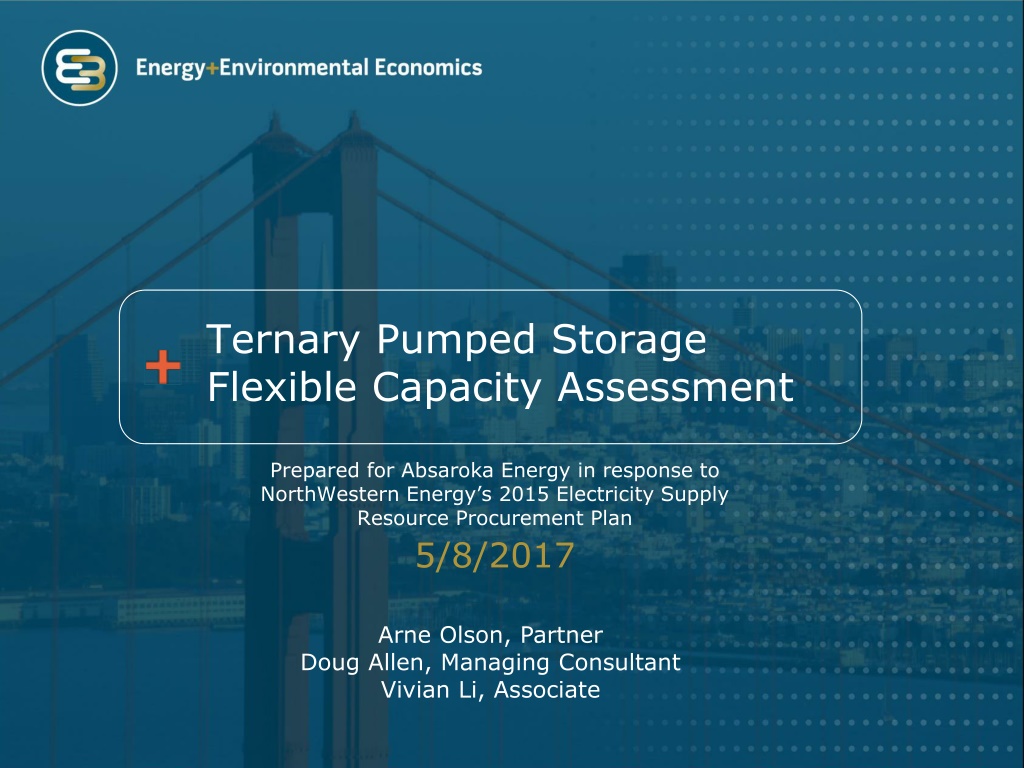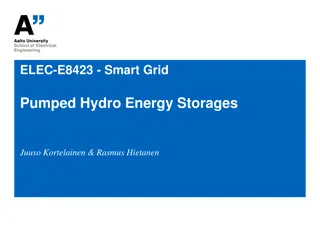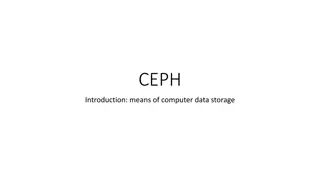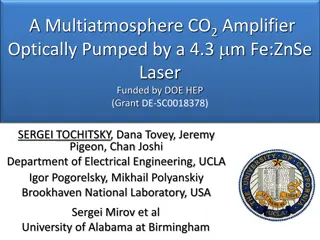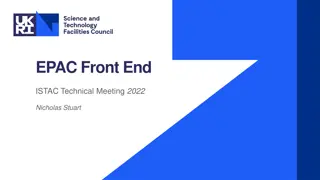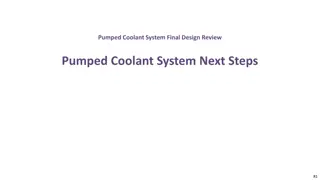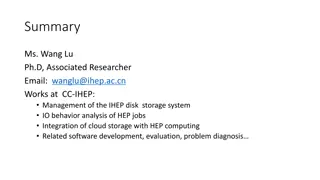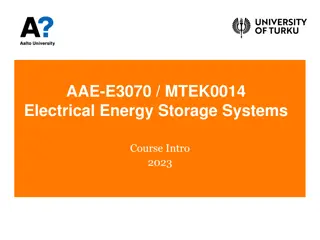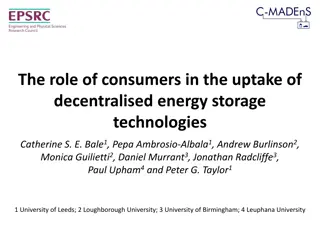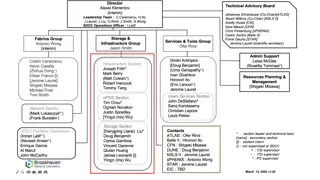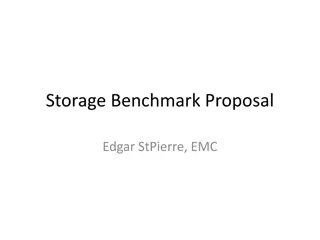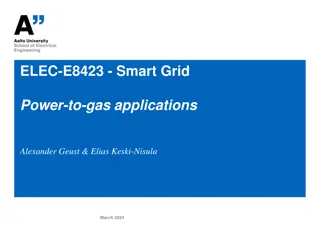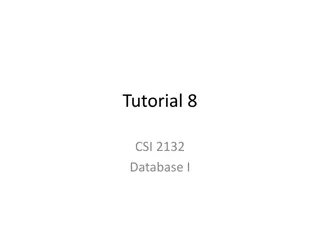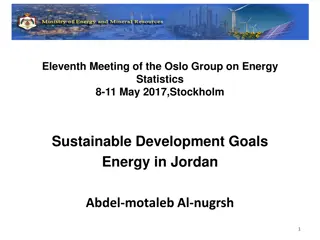Ternary Pumped Storage Flexible Capacity Assessment for Absaroka Energy
The assessment conducted by E3 compares Absaroka Energy's ternary pumped storage technology with conventional resources in terms of their ability to provide flexible capacity. The analysis looks at the cost comparison, system capacity, and ancillary services provided by different types of generating technologies. It focuses on the product-specific cost per kW by technology to allow for a balanced comparison of capacity costs.
Download Presentation

Please find below an Image/Link to download the presentation.
The content on the website is provided AS IS for your information and personal use only. It may not be sold, licensed, or shared on other websites without obtaining consent from the author. Download presentation by click this link. If you encounter any issues during the download, it is possible that the publisher has removed the file from their server.
E N D
Presentation Transcript
Ternary Pumped Storage Flexible Capacity Assessment Prepared for Absaroka Energy in response to NorthWestern Energy s 2015 Electricity Supply Resource Procurement Plan 5/8/2017 Arne Olson, Partner Doug Allen, Managing Consultant Vivian Li, Associate
Analysis Description Absaroka Energy LLC asked E3 to compare their ternary pumped storage technology to conventional resources in terms of their ability to provide flexible capacity Conventional resources considered: Internal Combustion (Reciprocating) Engine, Frame Combustion Turbine, Aeroderivative Combustion Turbine Flexible capacity does not have a specific definition, so we have looked at each resource s ability to provide System capacity Ancillary Services 2
Flexible Capacity Cost Comparison Nameplate Capacity Frequency Response Non-spinning Reserves Regulation Up/Down Spinning Reserves Provided by units that need not be synchronized to the grid, but are able to ramp up generation within specified time frame upon dispatch Mostimmediate response to deviations in grid frequency served by generator inertia Ability to provide capacity during peak events and contribute to required reserve margins Provided by generators that are online and have capacity to increase or decrease generation output or load consumption (pumping) Provided by units that are synchronized to the grid and, upon dispatch, able to ramp up within specified time frame Capital Cost Analysis Capital Costs ($ kW) $ Product Specific Cost = kW Product Specific Usable Capacity (%) * Capital costs considered in this analysis include infrastructure costs as detailed in the 2015 NWE Electricity Supply Resource Procurement Plan 3
Cost Comparison For each capacity product, we describe the ability of the different generating technologies to supply that product We then calculate the product-specific cost per kW by technology Allows for more balanced comparison of capacity cost than a simple $/kW installed cost This comparison focuses on costs per unit of flexible capacity only, and does not include an analysis of potential revenues 4
Comparison Scope This analysis looks solely at the comparative capital costs (per installed kW) of the different technologies Accounts for each technology s ability to provide different capacity services Does not account for Fuel / Variable Operating costs Revenues from participation in energy markets Potential impacts of carbon price or air quality operating restrictions Carbon benefits of absorbing renewable overgeneration for later use 5
Assumptions Natural Gas Simple Cycle Ternary Pumped Storage Aeroderivative Combustion Turbine (Aero) Operating Characteristic Pumped Storage Hydro (PS)* Internal Combustion Engine (ICE) Frame Combustion Turbine (Frame) Units Ternary Unit Warsila 18V50SG GE LMS100 GE 7EA Technology - 150 18 93 79 Capacity MW $2,439 $1,756 $1,684 $1,459 Capital Costs $/kW 300 4 10 4 Ramp Rate MW/min 0.4 1.5 not reported not reported not reported Start Time min 2 not reported not reported not reported Shut-down Time min not reported 1 8 8 Min Run Time Hours not reported 1 7 7 Min Down Time Hours -100% (pumping) +100% (generating) [min max, as % of capacity] 21%-100% 53%-100% 13%-100% Operating Range * Data provided by Absaroka All Data taken from Thermal Resource Operating Parameters section of the NorthWestern Energy 2015 Electricity Supply Resource Procurement Plan Assuming transfer mode as the final state of rest Includes Infrastructure costs as described in NWE s Procurement Plan 6
Nameplate Capacity Usable capacity provided by the unit (as listed in the NWE Procurement Plan) Reflects the unit s contribution to reserve margins / system capacity Amount of capacity available to meet peak capacity needs Capital Costs (2018 $/kW) Capacity Assumptions Generation rated power = 150 MW Pumping rated load = 150 MW PS $2,439 ICE Generation rated power = 18 MW $1,756 Aero Generation rated power = 93 MW $1,684 Frame Generation rated power = 79 MW $1,459 7
Flexible Capacity: Frequency Response Primary control - most immediate response to deviations in grid frequency Served by generator inertia Provided primarily by frequency responsive loads and synchronous generators Usable Capacity Range (% of Nameplate)* Capital Costs (2018 $/kW) Capacity Assumptions Inertia of turbine and generator provides frequency response Some markets offer fast- frequency regulation products PS 200% $1,220 ICE 79% $2,223 Primary response requirement for generators with governor function may exist Aero 47% $3,583 WECC specifies droop settings for conventional generators Frame 87% $1,677 *Assuming operating state is at optimal position for providing frequency response [ex. GT at Pmin] 8
Flexible Capacity: Regulation Up/Down Secondary control - occurs within seconds to minutes via automatic generation control Provided by generators who are online and have capacity to increase or decrease output Usable Capital Costs (2018 $/kW) Capacity Assumptions Capacity Range (% of Nameplate)* Capacity to increase/decrease system output by reducing/increasing generation or load Fast switching between modes doubles the effective range unit. PS 200% $1,220 ICE 79% $2,223 Capacity of conventional generators to provide regulation up and down is limited by ramp rate and minimum power generation levels. Aero 47% $3,583 Frame 87% $1,677 *Assuming operating state is at optimal position for providing frequency response [ex. GT at Pmin] Frame units are not usually used for Regulation given their limited operating flexibility 9
Spinning vs. Non-Spinning Reserves Spinning/Non-spinning reserves are used to meet the same operating reserve obligation Spinning Non-Spinning Minimum spinning reserves obligation Total reserves obligation Fast response of ternary pumped storage units allows for provision of either spinning or non- spinning reserves, even when in charging mode 10
Flexible Capacity: Spinning Reserves Tertiary control - system operator dispatches reserves in response to contingencies Provided by units that are synchronized to the grid and able to ramp up within specified time frame Usable Capacity Range (% of Nameplate)* Capital Costs (2018 $/kW) Capacity Assumptions Fast ramp rate and mode switching allows for fast response to operator dispatch Unit in generation, idling, or pumping mode Can increase/decrease load or generation Can switch from one mode to another PS 200% $1,220 ICE 79% $2,223 Limited by ramp rate, start-up times (hot-start) Aero 47% $3,583 Frame 87% $1,677 *Assuming operating state is at optimal position for providing frequency response [ex. PS pumping, GT at Pmin] 11
Flexible Capacity: Non-Spinning Reserves Tertiary control - system operator dispatches reserves in response to contingencies Provided by units that are not necessarily synchronized to the grid, but able to ramp up generation within specified time frame Required response time is slower than spinning reserves Usable Capacity Range (% of Nameplate)* Capital Costs (2018 $/kW) Capacity Assumptions Unit in standby mode If dispatched, can quickly ramp up capacity PS 200% $1,220 ICE 100% $1,756 Capacity and participation limited by ramp rate, start up time (cold-start) Aero 100% $1,684 Frame 100% $1,459 *Assuming operating state is at optimal position for providing frequency response [ex. PS pumping, GT not on] 12
Additional Flexible Capabilities Gordon Butte Pumped Storage Ternary Unit Operating Characteristic Aeroderivative CT Frame CT ICE Additional cost for each start Estimated median cold start cost* Can absorb overgeneration? Black start? Minimal Yes Yes Yes n/a $32/MW $103/MW Not provided Yes No No No Yes Yes** Yes** Yes** *Intertek APTECH (2012). Power Plant Cycling Costs. http://wind.nrel.gov/public/wwis/aptechfinalv2.pdf **Siemens (2006). Black Start Studies. https://w3.usa.siemens.com/datapool/us/SmartGrid/docs/pti/2006June/Black_Start_Studies.pdf 13
Conclusions Compared to the conventional resources described in NWE s 2015 IRP filing, Ternary Pumped Storage can provide the following services at a cheaper per-kW installed price: Frequency Response Regulation Up / Down Spinning Reserve Non-Spinning Reserve Beyond the ability to provide flexible and peak capacity considered here, this analysis does not reflect a pumped storage facility s ability to store energy for use later, which enables Absorption of overgeneration Arbitrage of energy price spreads Increased transmission system utilization 14
